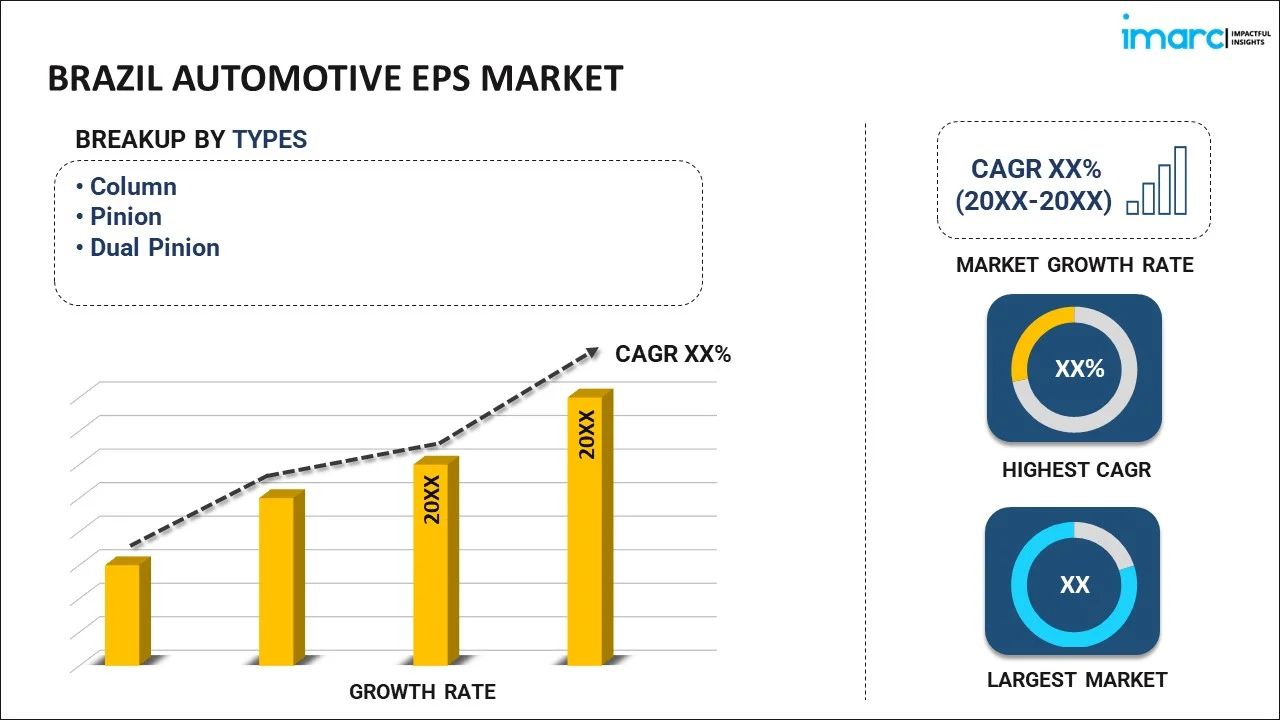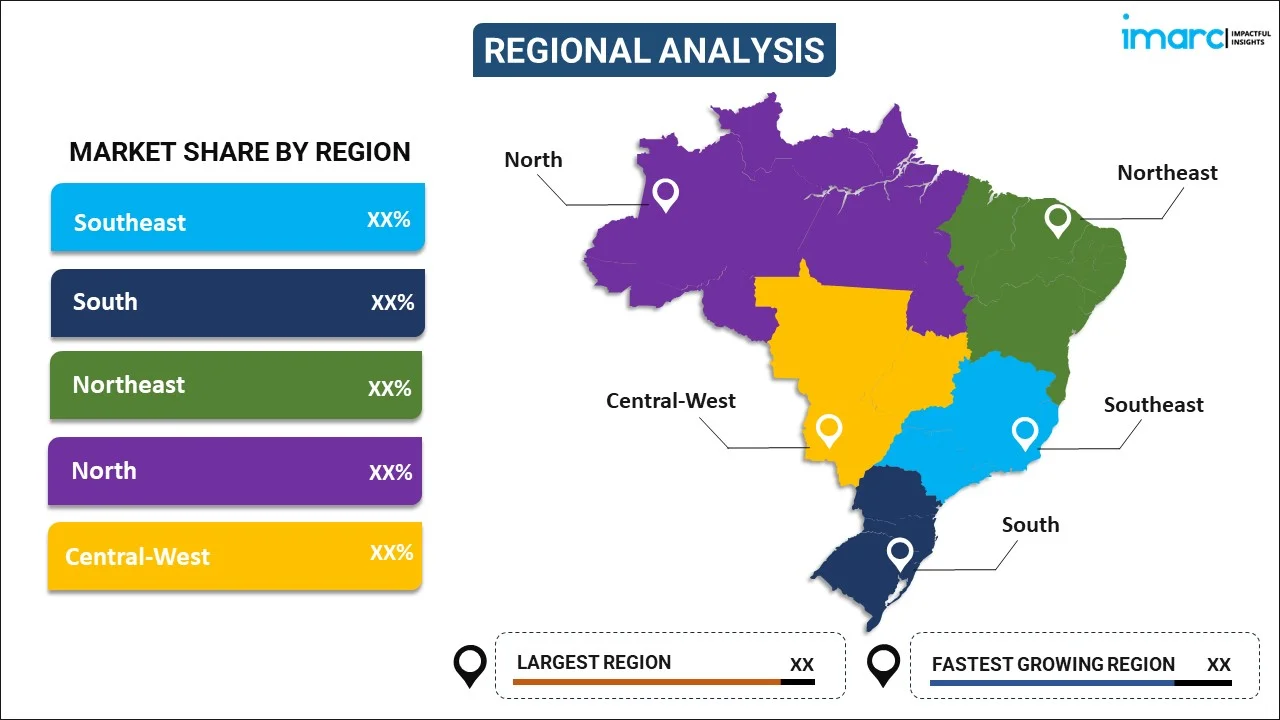
Brazil Automotive EPS Market Report by Type (Column, Pinion, Dual Pinion), Component Type (Steering Rack/Column, Sensor, Steering Motor, and Others), Vehicle Type (Passenger Cars, Commercial Vehicles), and Region 2025-2033
Market Overview:
Brazil automotive EPS market size reached USD 470.7 Million in 2024. Looking forward, IMARC Group expects the market to reach USD 647.1 Million by 2033, exhibiting a growth rate (CAGR) of 3.6% during 2025-2033. Emerging energy-efficient trends, shifting consumer preference for comfort and safety, localized production facilities, and effective marketing strategies represent some of the key factors driving the market.
|
Report Attribute
|
Key Statistics
|
|---|---|
|
Base Year
|
2024 |
|
Forecast Years
|
2025-2033
|
|
Historical Years
|
2019-2024
|
| Market Size in 2024 | USD 470.7 Million |
| Market Forecast in 2033 | USD 647.1 Million |
| Market Growth Rate (2025-2033) | 3.6% |
Automotive EPS (electric power steering) is a sophisticated steering system that has largely replaced traditional hydraulic power steering in modern vehicles. It operates using electrical power to assist the driver in steering the vehicle, enhancing control, comfort, and efficiency. Unlike hydraulic systems, which rely on a pump and fluid to provide assistance, EPS systems utilize an electric motor integrated into the steering column or rack-and-pinion assembly. This motor can adjust the level of assistance based on driving conditions, vehicle speed, and driver input, making it highly adaptable and responsive. Automotive EPS offers numerous advantages, including energy efficiency, as the electric motor only consumes power when assistance is needed, contributing to improved fuel economy. These systems also offer flexibility in tuning the steering feel, allowing automakers to customize the driving experience, from light and easy steering at low speeds to firmer and more stable handling at higher speeds. Automotive EPS is a pivotal technology in modern vehicle design, combining enhanced control, reduced energy consumption, and customizable steering characteristics to improve driver satisfaction and overall vehicle performance.
Brazil Automotive EPS Market Trends:
The growth of the Brazil automotive EPS market is primarily driven by the emerging trends toward the adoption of EPS systems over traditional hydraulic power steering in the automotive industry due to their numerous advantages. Besides this, the country's focus on energy efficiency and environmental sustainability and the introduction of numerous stringent environmental regulations are fueling the use of EPS systems as they are inherently more energy-efficient and consume power only when assistance is required. Moreover, the increasing consumer preference for enhanced driving comfort and safety features, allowing smoother and more adaptable steering assistance and making it easier to maneuver in urban traffic and parking situations, is propelling the demand for EPS-equipped vehicles. Concurrently, the integration of these systems with advanced driver-assistance systems (ADAS), enhancing safety by enabling features including lane-keeping assist and adaptive cruise control, is acting as another growth-inducing factor. In addition to this, the burgeoning growth of the Brazilian automotive market, driven by a rising middle class and urbanization, has led to an increase in production and sales of vehicles equipped with EPS systems, creating a favorable outlook for market expansion. Furthermore, automotive manufacturers and suppliers in Brazil are extensively investing in research and development (R&D) to produce locally tailored EPS solutions that meet the specific needs of the Brazilian market, which, in turn, is contributing to the market growth. Apart from this, the rising consumer awareness regarding the numerous benefits of EPS systems is prompting automakers and dealerships to adopt these systems as a selling point, thereby providing an impetus to the market growth.
Brazil Automotive EPS Market Segmentation:
IMARC Group provides an analysis of the key trends in each segment of the market, along with forecasts at the country level for 2025-2033. Our report has categorized the market based on type, component type, and vehicle type.
Type Insights:

- Column
- Pinion
- Dual Pinion
A detailed breakup and analysis of the market based on the type have also been provided in the report. This includes column, pinion, and dual pinion.
Component Type Insights:
- Steering Rack/Column
- Sensor
- Steering Motor
- Others
The report has provided a detailed breakup and analysis of the market based on the component type. This includes steering rack/column, sensor, steering motor, and others.
Vehicle Type Insights:
- Passenger Cars
- Commercial Vehicles
A detailed breakup and analysis of the market based on the vehicle type have also been provided in the report. This includes passenger cars and commercial vehicles.
Regional Insights:

- Southeast
- South
- Northeast
- North
- Central-West
The report has also provided a comprehensive analysis of all the major regional markets, which include Southeast, South, Northeast, North, and Central-West.
Competitive Landscape:
The market research report has also provided a comprehensive analysis of the competitive landscape in the market. Competitive analysis such as market structure, key player positioning, top winning strategies, competitive dashboard, and company evaluation quadrant has been covered in the report. Also, detailed profiles of all major companies have been provided.
Brazil Automotive EPS Market Report Coverage:
| Report Features | Details |
|---|---|
| Base Year of the Analysis | 2024 |
| Historical Period | 2019-2024 |
| Forecast Period | 2025-2033 |
| Units | Million USD |
| Scope of the Report | Exploration of Historical Trends and Market Outlook, Industry Catalysts and Challenges, Segment-Wise Historical and Future Market Assessment:
|
| Types Covered | Column, Pinion, Dual Pinion |
| Component Types Covered | Steering Rack/Column, Sensor, Steering Motor, Others |
| Vehicle Types Covered | Passenger Cars, Commercial Vehicles |
| Regions Covered | Southeast, South, Northeast, North, Central-West |
| Customization Scope | 10% Free Customization |
| Post-Sale Analyst Support | 10-12 Weeks |
| Delivery Format | PDF and Excel through Email (We can also provide the editable version of the report in PPT/Word format on special request) |
Key Questions Answered in This Report:
- How has the Brazil automotive EPS market performed so far and how will it perform in the coming years?
- What has been the impact of COVID-19 on the Brazil automotive EPS market?
- What is the breakup of the Brazil automotive EPS market on the basis of type?
- What is the breakup of the Brazil automotive EPS market on the basis of component type?
- What is the breakup of the Brazil automotive EPS market on the basis of vehicle type?
- What are the various stages in the value chain of the Brazil automotive EPS market?
- What are the key driving factors and challenges in the Brazil automotive EPS?
- What is the structure of the Brazil automotive EPS market and who are the key players?
- What is the degree of competition in the Brazil automotive EPS market?
Key Benefits for Stakeholders:
- IMARC’s industry report offers a comprehensive quantitative analysis of various market segments, historical and current market trends, market forecasts, and dynamics of the Brazil automotive EPS market from 2019-2033.
- The research report provides the latest information on the market drivers, challenges, and opportunities in the Brazil automotive EPS market.
- Porter's five forces analysis assist stakeholders in assessing the impact of new entrants, competitive rivalry, supplier power, buyer power, and the threat of substitution. It helps stakeholders to analyze the level of competition within the Brazil automotive EPS industry and its attractiveness.
- Competitive landscape allows stakeholders to understand their competitive environment and provides an insight into the current positions of key players in the market.
Need more help?
- Speak to our experienced analysts for insights on the current market scenarios.
- Include additional segments and countries to customize the report as per your requirement.
- Gain an unparalleled competitive advantage in your domain by understanding how to utilize the report and positively impacting your operations and revenue.
- For further assistance, please connect with our analysts.
 Inquire Before Buying
Inquire Before Buying
 Speak to an Analyst
Speak to an Analyst
 Request Brochure
Request Brochure
 Request Customization
Request Customization




.webp)




.webp)












